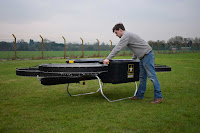Your ride to the office or even a pleasure trip will be faster,
higher and more energy efficient
CityAirbus
 It is a multi-passenger, autonomously piloted electric
flying car concept that can take-off and land vertically (VTOL). CityAirbus is
designed to carry up to four passengers over congested megacities to places
like airports or train stations in a fast and environment-friendly way. Its
integrated drivetrain includes eight propellers that deliver exceptional
torque-to-weight ratio. Its first flight is scheduled for the end of 2018.
It is a multi-passenger, autonomously piloted electric
flying car concept that can take-off and land vertically (VTOL). CityAirbus is
designed to carry up to four passengers over congested megacities to places
like airports or train stations in a fast and environment-friendly way. Its
integrated drivetrain includes eight propellers that deliver exceptional
torque-to-weight ratio. Its first flight is scheduled for the end of 2018.
Hoverbikes are coming to take motorbikes off the roads.
You can ride the Malloy Hoverbike or make it fly autonomously, deliver aid,
transport people and equipment over buildings, rivers and mountains. It has a
payload capacity of 130 kg, can reach an altitude of 9,000 feet and can fly at
a speed of more than 100 knots, or about 185 kmph.
Get ready to fly off like a superhero in a new breed of
solo flying machines. If the jet-powered carbon fibre wings invented by Swiss
aviator Yves Rossy go commercial, you will soon be able to fly through the
skies. Powered by four miniature jet engines, this wing unit can hit speeds of
up to 300 kmph.
Plimp airship
 The passenger version of Egan Airships’s Plimp (Model J)
can carry up to eight passengers and cruise at a speed of 100 kmph. The
unmanned aircraft systems (UAS) can manoeuvre and move quickly like fixed-wing
aircraft, hover and vertically take off and land like a helicopter. It uses
partial lift by helium, which is not flammable, and partial lift by its
rotational wings. Turn the engines off and the Plimp gently floats back to the
ground.
The passenger version of Egan Airships’s Plimp (Model J)
can carry up to eight passengers and cruise at a speed of 100 kmph. The
unmanned aircraft systems (UAS) can manoeuvre and move quickly like fixed-wing
aircraft, hover and vertically take off and land like a helicopter. It uses
partial lift by helium, which is not flammable, and partial lift by its
rotational wings. Turn the engines off and the Plimp gently floats back to the
ground.
Autonomous cars are on the horizon, but none can beat the
2020 Tesla Roadster, which can go from zero to 96.5 kmph in 1.9 seconds. Apart
from its record-setting acceleration, the Roadster has a range of 997 km with
one charge and a maximum speed of 420 kmph. It stores a removable glass roof in
the trunk for an open air, convertible driving experience.
Silent 55
The future of sailing is not going to be dependent on
wind or fossil fuels. An e-power catamaran, Silent 55, promises an unlimited
range on the high seas. It is powered by solar energy and can cruise up to 100
nautical miles a day. Inside, you can watch TV, run air-conditioning and
produce up to 2,000 lts of drinking water per day.



